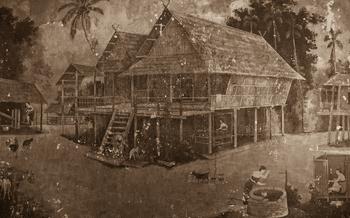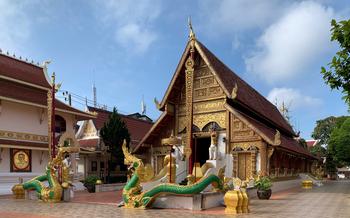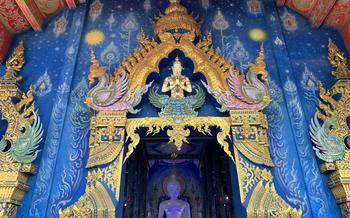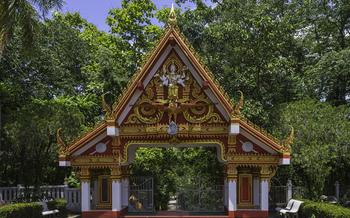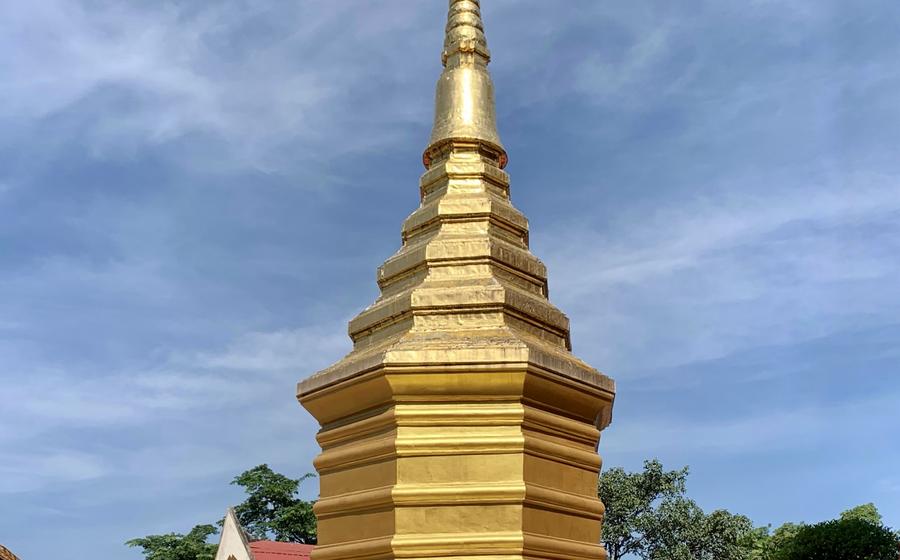
Wat Phra That Doi Chom Thong
- Wat Phra That Doi Chom Thong: A Sacred Mountaintop Temple
- Pilgrimage and Worship
- The Grand Stairway
- The Golden Pagoda
- The Emerald Buddha Replica
- Other Notable Structures
- Festivals and Events
- Local Markets and Handicrafts
- Accommodation and Dining Options
- Insider Tip: Supporting the Local Community
- Getting There and Transportation
- Opening Hours and Admission Fees
- Photography and Videography
- Insider Tip: Sunrise and Sunset Views
Wat Phra That Doi Chom Thong: A Sacred Mountaintop Temple
In the heart of Chiang Rai's stunning countryside, nestled atop Doi Chom Thong mountain, lies the sacred temple of Wat Phra That Doi Chom Thong, a revered pilgrimage site and one of Thailand's most significant religious landmarks. Steeped in history and imbued with profound spiritual significance, this magnificent temple complex offers visitors a glimpse into Thailand's rich Buddhist heritage while captivating them with its architectural splendor and panoramic vistas.
The temple's origins can be traced back to the 13th century, when it was constructed as a royal temple by King Mangrai, the founder of the Lanna Kingdom. Throughout the centuries, Wat Phra That Doi Chom Thong has undergone several renovations and expansions, each leaving its unique mark on the temple's architectural tapestry. Today, it stands as a testament to the enduring legacy of Lanna craftsmanship and devotion.
The temple's design exemplifies the classic Lanna architectural style, with intricate carvings, graceful stupas, and sweeping eaves that blend harmoniously with the surrounding landscape. The temple complex encompasses several structures, including the grand staircase, the golden pagoda, the ordination hall, the bell tower, and the viharn, each serving a distinct religious or ceremonial purpose.
Wat Phra That Doi Chom Thong is not just a historical and architectural marvel; it is also a deeply revered pilgrimage site for Buddhists from around the world. Devotees flock to pay homage to the sacred Buddha image enshrined within the temple's main stupa, seeking blessings, guidance, and spiritual fulfillment. The temple's serene atmosphere and stunning panoramic views add to its allure, making it a sanctuary for contemplation and a place of profound spiritual connection.
Pilgrimage and Worship
Wat Phra That Doi Chom Thong holds a profound religious significance, serving as a prominent pilgrimage site for Buddhists from Thailand and beyond. Devotees flock to the temple to pay homage to the sacred Buddha image enshrined within the golden stupa, seeking blessings and spiritual guidance.
Pilgrims engage in various rituals and ceremonies to express their devotion. They light incense sticks and offer flowers, candles, and other symbolic gifts to the Buddha image. Chanting prayers and mantras fills the air, creating a deeply spiritual atmosphere.
The temple's serene and tranquil environment fosters a sense of inner peace and contemplation. Visitors can immerse themselves in the sacred ambiance, meditate, and connect with their spiritual side. The temple's aura of holiness inspires a deep sense of reverence and awe in all who visit.
The Grand Stairway
The long staircase leading up to Wat Phra That Doi Chom Thong is not merely a means of ascent but a significant symbol in itself. With its 309 steps, it represents the journey one must undertake to reach enlightenment and spiritual fulfillment. The architectural design of the stairway is both impressive and intricate, with each step carefully crafted to provide a steady and comfortable climb.
The challenge of climbing the staircase is rewarded with breathtaking views and photo opportunities along the way. The lush greenery of the surrounding mountains, the shimmering waters of the Kok River, and the distant city of Chiang Rai create a picturesque panorama that is sure to leave visitors in awe. Taking breaks on the way up allows one to appreciate the beauty of the surroundings and catch a glimpse of the magnificent golden stupa that awaits at the summit.
The Golden Pagoda
The glistening centerpiece of Wat Phra That Doi Chom Thong is its majestic golden pagoda, towering over the temple grounds with an aura of sacred grandeur. This magnificent stupa, known as a chedi in Thai, is a testament to the exquisite craftsmanship and intricate artistry that adorn every corner of this sacred site.
Crafted with meticulous precision, the pagoda's shimmering golden exterior gleams under the radiant Thai sun, creating a mesmerizing spectacle that captures the hearts of all who behold it. Its intricate details and ornate embellishments showcase the profound religious and cultural significance it holds for the Buddhist community.
Ascending the chedi, visitors are rewarded with breathtaking panoramic vistas that stretch far and wide, encompassing the verdant landscapes, distant mountain ranges, and the sprawling city of Chiang Rai in the distance. The elevated vantage point offers a unique perspective, allowing visitors to fully appreciate the temple's grandeur and its harmonious integration with the natural surroundings.
Beyond its visual splendor, the golden pagoda holds deep religious symbolism. It represents the Buddha's victory over worldly temptations and his attainment of enlightenment. The chedi's towering presence serves as a constant reminder of the Buddha's teachings and the path to spiritual liberation.
For devotees, the golden pagoda is a sacred object of veneration. They offer prayers, make offerings, and perform rituals to seek blessings, express gratitude, and connect with the divine. The pagoda's radiant aura and the devout atmosphere that surrounds it create a profound sense of peace and serenity, making it a sanctuary for spiritual contemplation and reflection.
The Emerald Buddha Replica
The Emerald Buddha, enshrined in Wat Phra Kaew in Bangkok, is one of the most sacred and revered Buddha images in Thailand. At Wat Phra That Doi Chom Thong, visitors have the opportunity to pay homage to a replica of this iconic image. Enshrined within the temple's main stupa, the replica Emerald Buddha exudes a serene and majestic presence.
Crafted with meticulous attention to detail, the replica captures the essence and symbolism of the original. Its emerald green color, believed to represent purity and compassion, radiates a calming aura. The intricate carvings and embellishments adorning the image showcase the exceptional craftsmanship and artistry of Thai artisans.
Devotees and visitors alike show immense reverence and devotion to the Emerald Buddha replica. They offer prayers, light incense, and make offerings to seek blessings and pay their respects. The replica serves as a tangible connection to the original Emerald Buddha, allowing pilgrims and visitors to experience the spiritual significance and sacredness associated with this revered image.
Other Notable Structures
Apart from the main stupa, Wat Phra That Doi Chom Thong boasts several other notable structures that contribute to its architectural and religious significance.
-
The Ordination Hall: This grand hall serves as a sacred space for Buddhist monks to undergo ordination ceremonies. It showcases intricate carvings, colorful murals, and a majestic Buddha image.
-
The Bell Tower: The bell tower stands tall and proud, symbolizing the importance of time and mindfulness in Buddhist teachings. Its melodious chimes reverberate through the air, signaling the start of ceremonies and daily rituals.
-
The Viharn: The viharn, also known as the assembly hall, is a central gathering place for monks and devotees. It houses a collection of revered Buddha images, inviting visitors to pay homage and seek blessings.
-
The Chedi: Scattered throughout the temple grounds are several chedi, or stupas, each representing a different aspect of Buddhist teachings or commemorating important events. Their distinctive spires add to the temple's overall aesthetic appeal.
Festivals and Events
Wat Phra That Doi Chom Thong comes alive during its annual temple fair, typically held in February or March. This vibrant event attracts locals and visitors alike, offering a glimpse into the rich cultural traditions of the region. The fair features colorful processions, traditional music and dance performances, and a lively market selling local delicacies and handmade crafts.
Throughout the year, the temple also hosts various religious ceremonies and celebrations, such as Songkran (Thai New Year), Visakha Puja (Buddha's birthday), and Kathina (robe offering ceremony). These events provide an opportunity for devotees to pay homage to the Buddha and participate in merit-making activities.
Of particular significance are the Loi Krathong and Yi Peng festivals, which take place in November. During these festivals, visitors can release floating lanterns into the night sky, creating a mesmerizing spectacle of lights. The lanterns symbolize letting go of negative emotions and bringing good luck and prosperity.
Local Markets and Handicrafts
The area surrounding Wat Phra That Doi Chom Thong is a haven for local markets and handicraft shops, offering visitors a chance to immerse themselves in the vibrant culture of the region. From colorful textiles and intricate jewelry to hand-carved wooden sculptures and traditional ceramics, there's something to suit every taste and budget.
The markets are a great place to pick up unique souvenirs and gifts, or simply browse the stalls and enjoy the lively atmosphere. Be sure to haggle for the best prices, and don't be afraid to ask the vendors about the stories behind their products.
By supporting the local markets, you'll not only take home a piece of Thailand with you, but you'll also contribute to the livelihoods of the local community.
Here are some tips for shopping at the local markets:
- Bargain politely: It's expected to haggle at the markets, but be respectful and don't be afraid to walk away if you can't agree on a price.
- Ask about the products: Many of the vendors are artisans who make their own products. Ask them about their process and the materials they use.
- Look for unique finds: The markets are a great place to find one-of-a-kind items that you won't find anywhere else.
- Support the local community: By buying from the local markets, you're helping to support the livelihoods of the people who live in the area.
Accommodation and Dining Options
The immediate vicinity of Wat Phra That Doi Chom Thong offers a range of accommodation options to suit different budgets and preferences. For a truly immersive experience, consider staying at a nearby guesthouse or hotel, where you can soak in the local ambiance and enjoy easy access to the temple. These accommodations often feature traditional Thai-style architecture, blending harmoniously with the sacred surroundings.
When it comes to dining, the area surrounding the temple is dotted with local restaurants serving up authentic Thai cuisine. Indulge in the flavors of aromatic curries, spicy salads, and freshly caught seafood dishes. Vegetarian and vegan options are also available for those with dietary restrictions. For a budget-friendly and authentic experience, venture into the local markets, where you can find delicious street food and fresh produce at affordable prices.
Insider Tip: Supporting the Local Community
As you explore the markets near the temple, take the opportunity to support the local community by purchasing unique handicrafts and souvenirs. These items are often handmade by skilled artisans, and your purchases directly contribute to their livelihoods. From intricate wood carvings to colorful woven textiles, there's a treasure trove of unique finds to discover. Engage in friendly bargaining to score the best prices while respecting the artisans' fair wages.
Getting There and Transportation
The journey to Wat Phra That Doi Chom Thong begins in Chiang Rai, situated approximately 20 kilometers away. From the city center, one can embark on a scenic 45-minute drive, following the winding roads that lead to the temple's majestic peak. Embrace the freedom of renting a motorbike, allowing you to navigate the countryside at your own pace and revel in the picturesque surroundings. Alternatively, opt for the convenience of hiring a taxi, ensuring a comfortable and hassle-free journey to the temple's gates.
When negotiating fares with local taxi drivers, remember to approach the conversation with a friendly and respectful demeanor. Inquire about the standard rates for the route and be prepared to bargain politely. This amicable approach will often lead to a fair and reasonable fare, enabling you to embark on your pilgrimage without any unnecessary financial burdens.
Opening Hours and Admission Fees
Wat Phra That Doi Chom Thong is open to visitors every day of the week from 6:00 AM to 6:00 PM. The temple encourages donations, but there is no official entrance fee. However, a small donation is customary to show respect and support the temple's upkeep. Discounts and concessions are available for students and seniors with valid identification.
When visiting the temple, it is important to dress respectfully. Visitors should avoid wearing shorts, tank tops, or revealing clothing. It is also customary to remove shoes before entering the temple grounds and sacred areas. Visitors should be mindful of their behavior and maintain a peaceful and contemplative atmosphere while exploring the temple.
Photography and Videography
The beauty and serenity of Wat Phra That Doi Chom Thong are best captured through the lens of a camera. Photography and videography are allowed within the temple grounds, but it is essential to respect the sacred nature of the site.
When taking photos, be mindful of the monks and other visitors, and avoid capturing them without their permission. It is also important to refrain from using flash photography, as this can be disruptive to religious ceremonies.
To capture the essence of the temple, focus on the intricate details of the architecture, the stunning panoramic views, and the devout pilgrims who come to pay their respects. The golden stupas, the colorful murals, and the serene surroundings provide ample opportunities for creating beautiful and memorable shots.
If you plan to take videos, ensure that the sound is turned off or kept to a minimum, as loud noises can disturb the peaceful atmosphere of the temple.
By following these simple guidelines, you can capture the beauty of Wat Phra That Doi Chom Thong while respecting its sacredness and tranquility.
Insider Tip: Sunrise and Sunset Views
For an unforgettable experience, plan your visit to Wat Phra That Doi Chom Thong during sunrise or sunset. As the golden hues of dawn illuminate the temple grounds, you'll witness a breathtaking spectacle of light and shadow. The silhouette of the pagoda against the vibrant sky creates a magical ambiance, perfect for capturing stunning photographs. Alternatively, as the sun descends, the temple glows with a warm, ethereal light, casting a serene glow over the surrounding landscape. Whether you're a photographer, a nature enthusiast, or simply seeking a moment of tranquility, the sunrise and sunset at Wat Phra That Doi Chom Thong offer an unforgettable experience that will leave you spellbound. Remember to arrive early to secure a good spot and soak in the tranquility of the temple before the crowds arrive.
